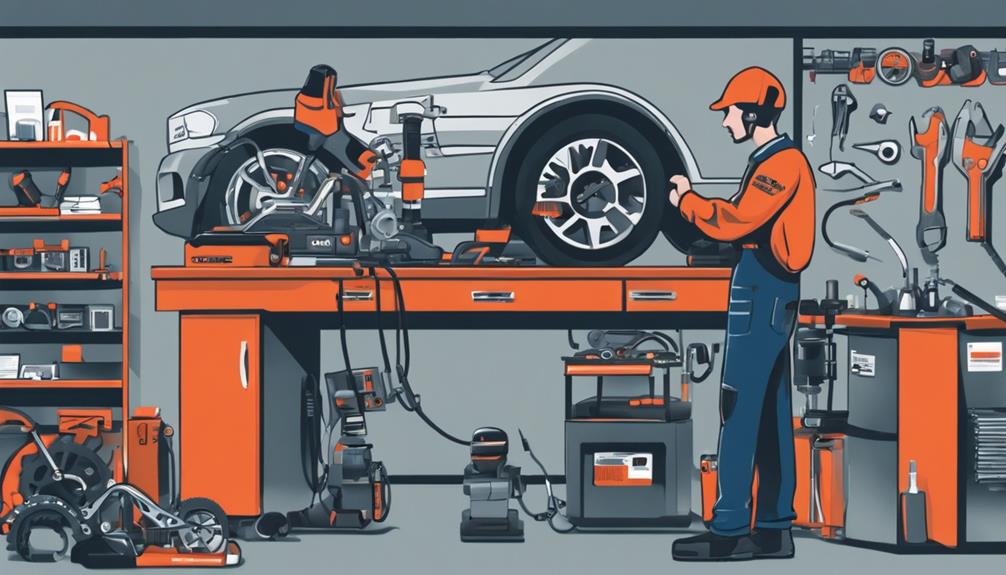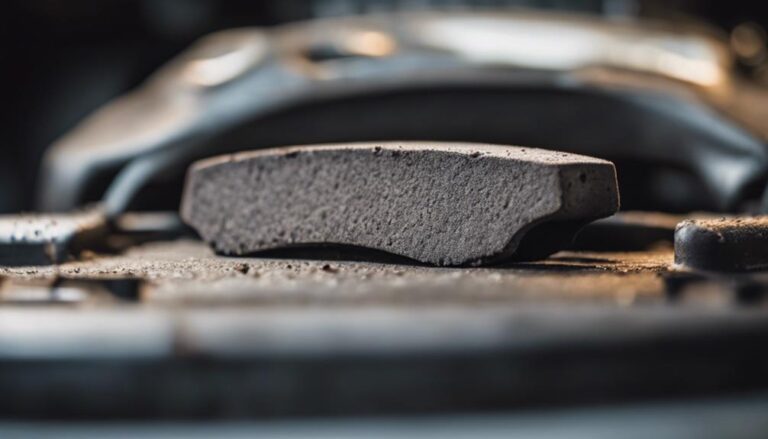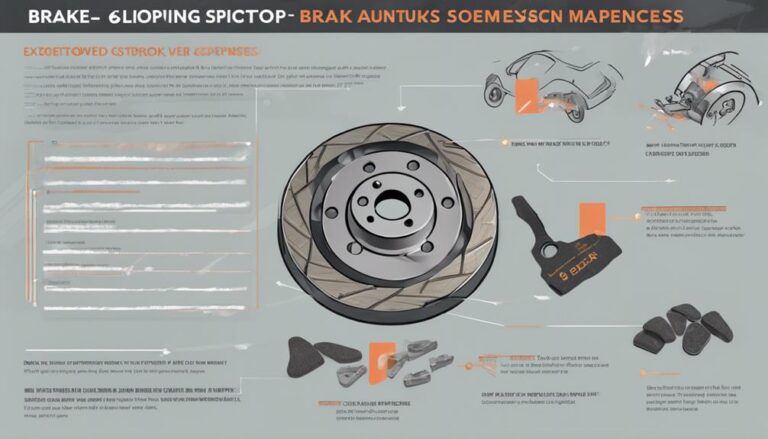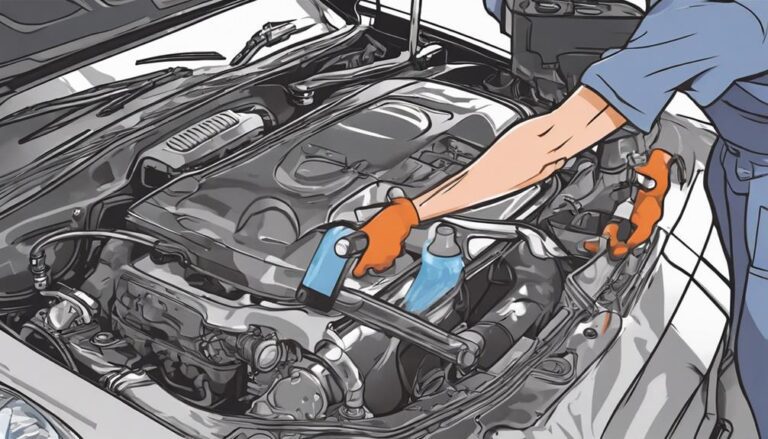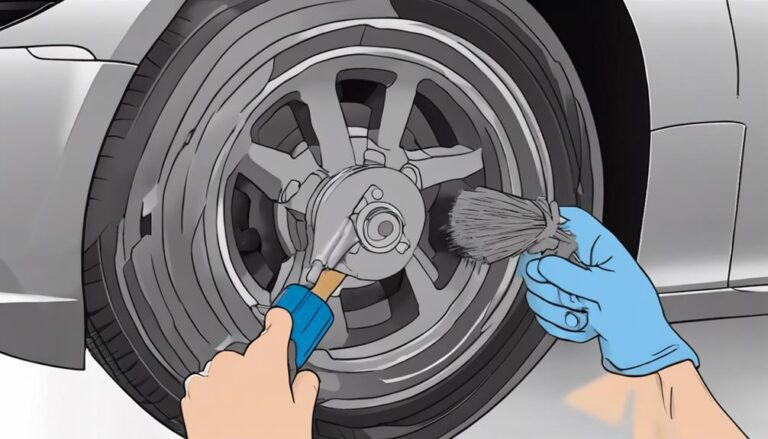Mastering ABS Brake System Maintenance: 7 Essential Tips
When it comes to mastering ABS brake system maintenance, think of it as steering a ship through turbulent waters – smooth sailing requires precision and attention to detail. Understanding the intricacies of your anti-lock brake system is crucial for optimal performance on the road.
By implementing seven essential tips for upkeep, you can safeguard yourself and your vehicle in critical braking situations. So, how can you ensure your ABS is always ready to respond when you need it the most?
Key Takeaways
- Regular inspections ensure ABS system integrity and safety.
- Proper brake pad maintenance enhances ABS performance.
- Follow correct bleeding techniques for optimal hydraulic pressure.
- Address warning signs promptly to maintain efficient ABS braking.
Understanding ABS Brake System Functions
Understanding how the ABS brake system functions is crucial for maintaining optimal vehicle control during braking situations. The ABS prevents wheel lock-up by modulating brake pressure, a critical function in avoiding skidding.
This system relies on ABS sensor calibration to accurately detect wheel speed and adjust braking force accordingly. By briefly releasing and reapplying the brakes, ABS ensures that the wheels keep rolling, preventing skidding and allowing you to steer during emergency braking situations.
This technology significantly enhances braking control and safety, especially during abrupt stops. Remember that the ABS system typically activates at speeds above 10 mph, so it's essential to familiarize yourself with its operation to maximize its benefits.
Implementing proper emergency braking techniques, such as maintaining steady pressure on the brake pedal while steering to avoid obstacles, complements the ABS system's capabilities in preventing accidents and maintaining vehicle stability. Mastering these aspects will empower you to navigate challenging road conditions with confidence.
Importance of Regular Inspections
Regular inspections play a vital role in maintaining the integrity of your ABS brake system. By adhering to a regular inspection schedule, you can promptly address any signs of wear or potential issues.
Ensuring the safety and optimal performance of your ABS requires vigilance in monitoring its components and functionality.
Inspection Frequency
Have you considered how often your ABS brake system should undergo inspections to ensure optimal performance and safety on the road?
Following the recommended inspection intervals as specified in your vehicle manual is crucial. These inspections, performed using diagnostic tools, allow for the thorough examination of system components and the implementation of troubleshooting techniques.
Regular assessments help in detecting potential issues early, such as worn components, leaks, or sensor malfunctions. By adhering to a consistent inspection schedule, you can prevent costly repairs and ensure a safe driving experience.
Stay proactive with your ABS brake system maintenance to maintain its functionality and your peace of mind on the road.
Signs of Wear
To ensure your ABS brake system's optimal performance and safety, paying attention to signs of wear through regular inspections is crucial. Signs of wear such as brake pad wear, sensor malfunction, rotor damage, and ABS warning lights can indicate potential issues that need to be addressed promptly. Conduct visual inspections of components like brake pads, rotors, and sensors to identify any visible signs of wear. Additionally, staying vigilant for changes in braking performance or unusual noises during braking can help catch problems early. Monitoring ABS warning lights and system alerts is essential, as they can be early indicators of wear or malfunctions. Addressing these signs of wear promptly can prevent further damage and ensure your ABS system operates at its best.
| Signs of Wear | Examples |
|---|---|
| Brake pad wear | Thinning brake pads |
| Sensor malfunction | Faulty ABS sensor |
| Rotor damage | Warped or scored rotors |
| ABS warning lights | Illuminated dashboard lights |
Safety Considerations
For optimal safety and performance of your vehicle's ABS brake system, prioritize regular inspections to detect potential issues early. Ensuring compliance with recommended maintenance schedules is crucial in maintaining the effectiveness of your ABS system.
By conducting routine inspections, you not only safeguard yourself and others on the road but also prevent costly repairs that may arise from neglected issues. Emergency preparedness is enhanced when you proactively monitor the condition of your ABS components, ensuring they function as intended during critical moments.
Regular maintenance checks offer peace of mind while driving, knowing that your ABS system is in top condition to assist you in sudden braking situations. Stay ahead of potential problems by incorporating thorough inspections into your vehicle maintenance routine.
Changing Brake Pads Correctly
When changing brake pads correctly, ensure proper pad alignment for even wear and optimal braking performance.
Remember to lubricate the caliper guide pins to prevent sticking and promote smooth brake operation.
Following these steps meticulously is essential for maintaining the integrity of your ABS brake system.
Proper Pad Alignment
Properly aligning brake pads is crucial for ensuring optimal performance and longevity of your ABS brake system. Utilizing correct pad alignment techniques during installation is key to prevent issues like uneven wear, which can decrease pad lifespan.
Misalignment may result in uneven braking, reduced stopping power, and potential rotor damage. Moreover, properly aligned brake pads contribute to maintaining consistent braking performance and preventing brake noise. Aligning pads correctly not only ensures optimal brake system efficiency but also enhances safety on the road.
Troubleshooting any alignment discrepancies promptly is essential to address issues that may arise. Remember, following manufacturer guidelines for pad alignment is fundamental for effective brake function and overall system health.
Lubricate Caliper Guide Pins
Ensuring that the caliper guide pins are properly lubricated is crucial during brake pad replacement to prevent issues such as brake pad binding and uneven wear, maintaining optimal braking performance and system integrity.
Proper preventive maintenance includes applying a high-temperature brake lubricant specifically designed for caliper guide pins to prevent seizing and ensure smooth caliper movement.
Before installing new brake pads, clean the guide pins thoroughly and inspect for any signs of wear or damage. Apply the lubricant evenly on the pins, ensuring complete coverage to promote consistent braking force distribution.
Regularly lubricating the caliper guide pins as part of your brake pad replacement routine is essential for safe and efficient braking performance, helping to avoid potential brake system malfunctions.
Monitoring Brake Fluid Levels
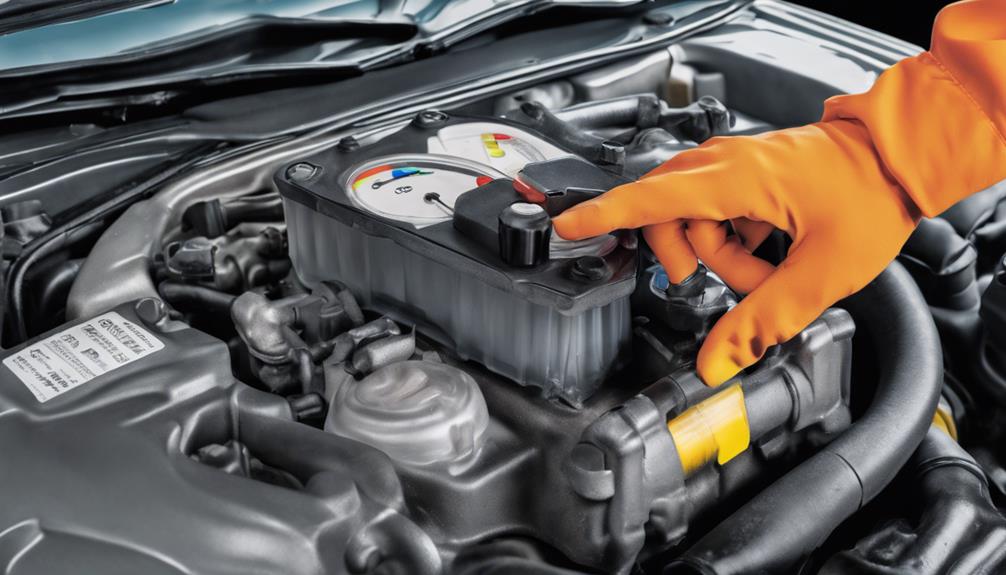
To maintain optimal performance of your ABS brake system, it is crucial to regularly monitor the levels of brake fluid in your vehicle. Checking indicators and preventing leaks are essential steps in ensuring your ABS system functions properly. Low brake fluid levels can lead to decreased braking performance and potential ABS malfunctions. It is vital to maintain the correct amount of brake fluid for the hydraulic operation of the brake system. Regularly inspect the color and clarity of the brake fluid for any signs of contamination or degradation. Follow the manufacturer's recommendations regarding the type of brake fluid to use and the frequency of checks to prevent ABS issues.
| Brake Fluid Monitoring | |||
|---|---|---|---|
| Steps | Significance | Actions Needed | Frequency |
| Check fluid level | Ensures proper function | Top up if low | Regularly |
| Inspect fluid color | Indicates contamination | Replace if necessary | During checks |
| Monitor clarity | Shows fluid degradation | Flush system if needed | Periodically |
Bleeding the Brake System Properly
When bleeding the brake system, it's crucial to follow the specific procedure outlined in your vehicle manual to maintain optimal hydraulic pressure and ensure consistent brake performance.
When it comes to brake bleeding techniques, precision is key to removing air bubbles effectively. Here are three essential tips to help you bleed your brake system properly and troubleshoot common issues:
- Start from the Farthest Point: Begin bleeding the brake system from the wheel farthest from the master cylinder and work your way towards the closest wheel. This ensures that all air bubbles are pushed out effectively.
- Use the Correct Bleeding Method: Whether you opt for the traditional pump-and-hold method or a pressure bleeding tool, ensure you follow the manufacturer's recommended technique to prevent any air from being reintroduced into the system.
- Check for Leaks and Re-Bleed if Necessary: After bleeding the brakes, inspect the system for leaks. If leaks are present, address them promptly and re-bleed the brakes to maintain optimal brake performance.
Cleaning and Maintaining Rotors
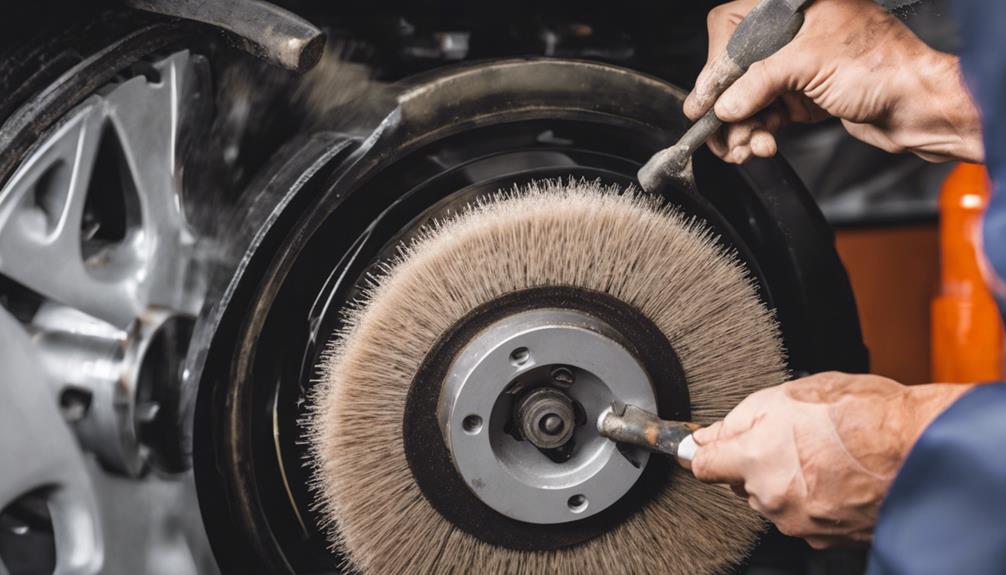
After properly bleeding your brake system, the next critical step is to focus on cleaning and maintaining the rotors to ensure optimal braking performance. Rotor maintenance is crucial for efficient braking.
Regularly clean the rotors using brake cleaner techniques to eliminate dust, debris, and brake pad material buildup that can impede performance. Inspect the rotors for signs of uneven wear, warping, or grooves that could affect braking efficiency. Use a wire brush to scrub the rotor surface and eliminate any surface rust or corrosion that may hinder proper function.
It's essential to verify that the rotor thickness falls within the manufacturer's specifications to uphold optimal braking capabilities. If the rotors are worn beyond the recommended limit, consider resurfacing or replacing them to guarantee safe braking performance.
Recognizing Warning Signs
Regularly monitor your ABS brake system for warning signs of potential issues to ensure optimal performance and safety on the road. Recognizing these signs early can help you address problems promptly and prevent further damage.
Here are three key indicators that may signal ABS brake system issues:
- ABS Warning Light: If the ABS warning light illuminates on your dashboard, it indicates a potential problem with the system. Using troubleshooting techniques and diagnostic tools can help identify the specific issue causing the warning light to come on.
- Unusual Noises: Pay attention to any unusual noises, such as grinding or squealing, when applying the brakes. These sounds could be a sign of ABS problems that require immediate attention and quick fixes to prevent further complications.
- Brake Pedal Vibrations: Feeling a pulsation or vibration in the brake pedal while braking can be a red flag for ABS issues. Emergency procedures may be necessary to address this issue promptly and ensure your ABS system functions correctly.
Frequently Asked Questions
What Are the 3 S's of ABS Braking?
When braking with ABS, remember the 3 S's: 'Stomp' firmly on the pedal, 'Stay' with pressure during activation, and 'Steer' to safety. These actions aid in speed control and slip prevention, crucial in emergency braking situations.
What Is the Maintenance of ABS Brakes?
To maintain ABS brakes, regularly check brake fluid, inspect pads and rotors, and test wheel speed sensors. Troubleshoot with DIY repairs like sensor cleaning or seek professional services for complex issues. Stay proactive; prioritize safety.
What Are the Five Keys to Brake Maintenance?
Ensure proper brake maintenance with regular checks. Replace brake pads as needed, check fluid levels, resurface rotors, and inspect sensors. Stay vigilant for signs of wear or leaks. Maintain safety by addressing issues promptly.
What Are the Three Rules for Using ABS Brakes?
When using ABS brakes, apply firm, continuous pressure for proper activation. Avoid pumping the pedal to let the system regulate pressure effectively. Maintain a steady grip on the wheel for control and stability.
Conclusion
Now that you have mastered the 7 essential tips for ABS brake system maintenance, remember that proper upkeep is key to ensuring your vehicle's safety and performance.
By staying proactive and attentive to your anti-lock brake system, you can be prepared for any emergency braking situation that may come your way.
Keep these tips in mind and drive with confidence knowing that your ABS is in optimal condition. Stay safe on the road.

